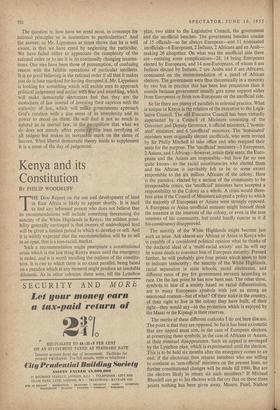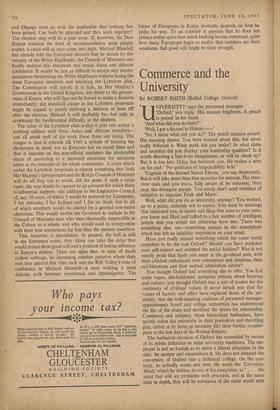Kenya and its Constitution
BY PHILIP WOODRUFF , THE Dow Report on the use and development of land in East Africa is likely to appear shortly. It is hard to find any informed person who does not believe that' its recommendations will include something threatening the sanctity of the White Highlands in Kenya; the mildest possi- bility generally envisaged is that owners of undeveloped land will be given a limited period in Which to develop or sell. And it is widely expected that the recommendation will be to sell in an open, that is a non-racial, market. . Such a recommendation might precipitate a constitutiOnal crisis which is the last thing,Kenya wants until the emergency is ended, and it is worth recalling the outlines of the constitu- tion. It is one to which there is no exact parallel, being based on a paradox which at any moment might produce an insoluble dilemma. As in other colonies, there were, till the Lyttelton 'plan, two sides to the Legislative Council, the government and the unofficial benches. The government benches consist of 15 officials—so far always European—and 11 nominated unofficials-6 Europeans, 2 Indians, 2 Africans and an Arab— making 26 altogether. On what was the unofficial side there are—omitting some complications-28, 14 being Europeans elected by Europeans, and 14 non-Europeans, of whom 6 are Indians elected by Indians, 2 are Arabs and 6 are Africans, nominated on the recommendation of a .panel of 'African electors. The government were thus theoretically in a minority by two but in practice this has been less precarious than it sounds because government usually gets some support either from Europeans or from non-Europeans on the unofficial side.
So far there are plenty of parallels in colonial practice. What is unique in Kenya is the relation of the executive to the Legis- lative Council. The old Executive Council has been virtually superseded by a Council of Ministers consisting of the Governor and Deputy Governor, 6 official ministers, 2 'nomin- ated' ministers, and 6 'unofficial' ministers. The 'nominated' ministers were originally elected unofficials, who were invited by Sir Philip Mitchell to take office and who resigned their seats for the purpose. The 'unofficial' ministers-3 Europeans, 2 Asians, and 1 African—however, retain their seats; the Euro- peans and the Asians are responsible—but how far no one quite knows—to the racial constituencies who elected them and the African is inevitably felt to be to some extent responsible to the six million Africans of the colony. Here is the paradox; elected by a section of the community to be irresponsible critics, the 'unofficial' ministers have accepted a responsibility to the Colony as a whole. A crisis would there- fore arise if the Council of Ministers adopted a policy to which the Majority of Europeans or Asians were strongly opposed. A European or Asian unofficial minister might himself think the measure in the interests of the colony, or even in the true interests of his community, but could hardly concur in it if his constituency disapproved.
The sanctity of the White Highlands might become just such an issue. Ask almostany African or Asian in Kenya who is capable of a considered political opinion what he thinks of the declared ideal of a 'multi-racial society' and ho will say he wants deeds to convince him of European sincerity. Pressed further, he will probably give four points which seem to him to indicate insincerity : the sanctity of the White Highlands, racial separation in state schools, racial electorates, and different rates of pay for government servants according to race. On the .last point he has now been met. The other three, symbols, to him of a society based on racial differentiation, are to 'many Europeans sYmbols with just as strong an emotional content—but of what? Of their stake in the country. of, their right to live in the colony they have built, of their right—they would say—to the protection which is enjoyed by the Masai or the Kipsagi in their reserves.
The merits of these different outlooks I do not here discuss. The point is that they are opposed. So far it has been axiomatic that any appeal must aim, in the case of European electors, at preserxing these symbols; in the case of Africans or Asians, at their eventual disappearance. Such an appeal is envisaged by the Lyttelton plan, which is experimental until the election. This is to be held six months after the emergency comes to an end; if the electorate then returns members who are willing to continue as 'non-bfficial' ministers on the present lines, no further constitutional changes will be made till 1960. But are the electors likely to return six such members? If Michael Blundell can go to his electors with the cry that on these three points nothing has been given away, Messrs. Patel, Nathoo and Ohanga must go with the confession that nothing has been gained. Can both be returned and then work together? The election may well be a year away. If, however, the Dow Report contains the kind of recommendation most people expect, a crisis will at once come into sight. Michael Blundell has already told the European electors that he stands by the sanctity of the White Highlands; the Council of Ministers can hardly endorse this statement and retain Asian and African confidence. It would be just as difficult to accept any recom- mendation threatening the White Highlands without losing the three European members and wrecking the Lyttelton plan. The Commission will, report, it is true, to Her Majesty's Government in the United Kingdom, not direct to the govern- ment of Kenya, who will this not be forced to make a decision immediately; the standstill clause in the Lyttelton proposals might be argued to justify shelving a decision at least till after the election. Shelved it will probably be—but only to accentuate the fundamental difficulty at the election.
The value of the Lyttelton plan is that it puts into action a working cabinet with three Asian and African members— and all speak well of the work those three are doing. The danger is that it extends till 1960 a system of training the electorates to think not as Kenyans but on racial lines and that it imposes on the non-official ministers the intolerable strain of answering to a sectional electorate for decisions taken in the interests of the whole community. A crisis which ended the Lyttelton proposals is clearly something that both Her Majesty's Government and the Kenya Council of Ministers will do all they can to avoid. All the same, if such a crisis came, the way would be opened to an advance for which there is influential support—the addition to the Legislative Council of, say, 10 seats, of which 3 would be reserved for Europeans, 3 for Africans, 3 for Indians and 1 for an Arab, but to all of which members would be elected by a general non-racial electorate. This would enable the Governor to include in his Council of Ministers men who were eleetorally responsible to the Colony as a whole, and who would need to compromise with their true convictions far less than the present members. This, however, is speculation. At present, the ball is still in the European court; they alone can take the steps that would ensure them good will and a position of lasting influence in Kenya's destiny. There are signs that, in spite of much violent verbiage, an increasing number perceive where their own true interest lies. One such was the Rift Valley's vote of confidence in Michael Blundell—a man walking a most delicate path between impatience and intransigence. The future of Europeans in Kenya probably depends on how he picks his way. To an outsider it appears that he does not always realise quite how much backing he can command, quite how many Europeans begin to realise that numbers are their weakness, thit good will might be their strength.











































 Previous page
Previous page